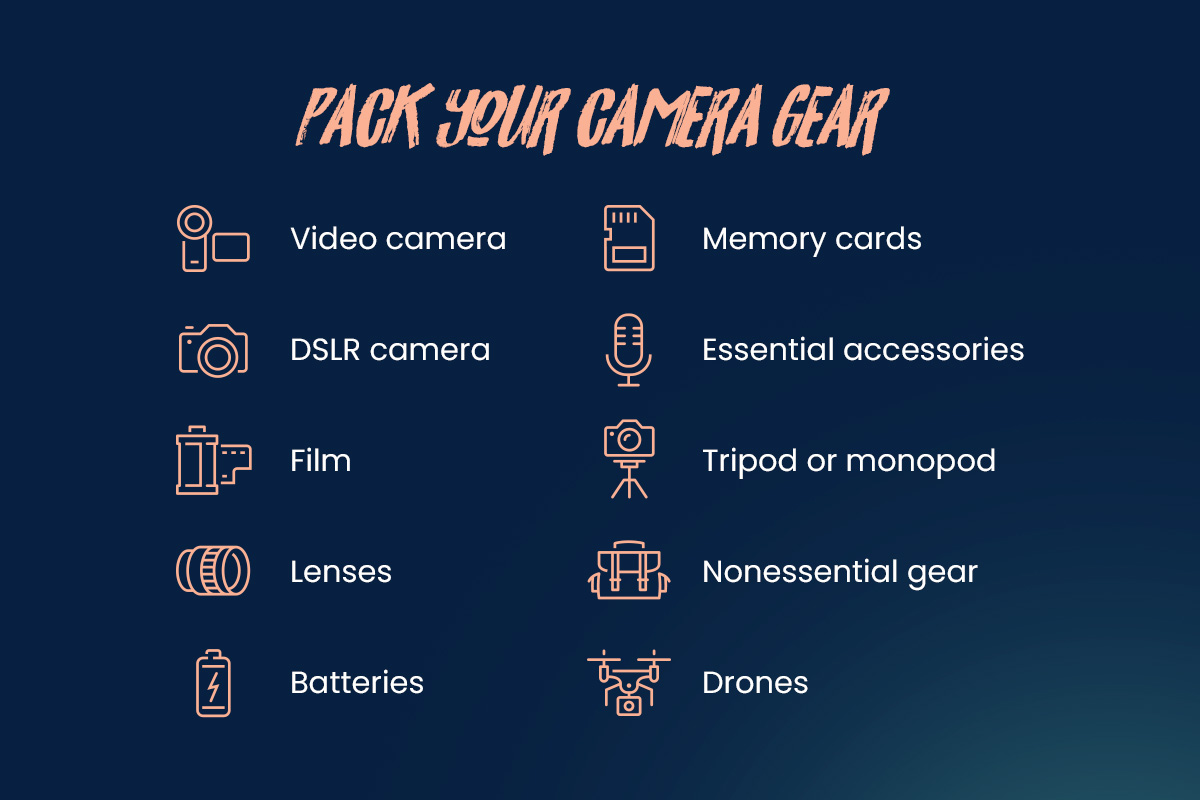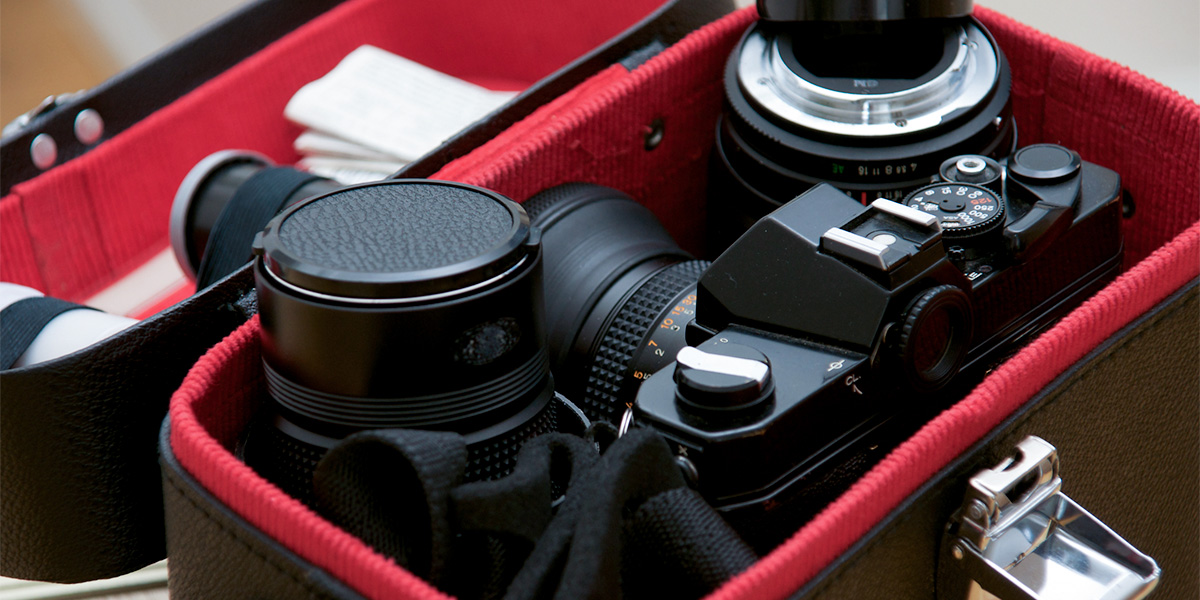Can you bring cameras on a plane? Traveling provides many opportunities for videographers and photographers working in the wedding industry. You can reach a broader range of clients, build relationships with other industry professionals and develop your skills while expanding your portfolio. As a growing wedding professional, you’re excited about the enriching experience of traveling for work.
Your camera is a gem, but it’s also your livelihood, so you need to treat it as such. You can take a camera on the plane, but you must consider airline regulations, keeping your gear secure and protecting it during air travel.
If you’re new to traveling as a wedding professional, follow our actionable tips for flying with a camera.
Prepare Your Gear for Travel
When flying with camera gear, planning before your trip will set the foundation for a smooth journey. Here are some tips to help you get ready before you start packing:
- Create an equipment checklist: Write a detailed inventory list of all your camera gear, including cameras, lenses, microphones and other accessories. This will help you keep track of everything and ensure you won’t forget any essential items. Bring extra batteries and spare memory cards to ensure you have enough storage for your shoots.
- Find quality camera bags: Invest in a padded camera bag or hard case specifically designed for travel. Look for bags with customizable compartments to fit your gear snugly. A hard case provides extra protection against impact, while a soft bag may be easier to carry.
- Research airline regulations: Look up your airline’s specific regulations for carrying camera gear. Understanding luggage size restrictions and any special requirements for transporting batteries or electronic devices will help you avoid surprises at the airport.
- Prepare travel documents: Organize any necessary travel documents, like permits for filming at specific locations, contracts with clients and invoices or papers that show ownership of your gear. Another little pearl of wisdom — always insure your camera gear.
Pack Your Camera Gear

Now, where to pack what — can you take your camera in a carry-on bag? Should you put camera lenses in your luggage? Here’s our advice on how to pack your gear effectively and where you should place items according to the Transportation Security Administration (TSA):
- Video camera: Always carry your primary camera bodies in your hand luggage to prevent loss or damage. If you have extra camera bodies that you can live without during the flight, consider packing them in checked luggage.
- DSLR camera: You can take a DSLR camera on a plane with your carry-on bag. If your airline allows a personal item, you can also use a small camera bag that fits under the seat.
- Film: Place any undeveloped film in your hand or checked luggage.
- Lenses: Bring essential lenses, especially your main and specialty lenses, in your carry-on bag. Extra lenses can go in checked luggage, but pack them with enough padding.
- Batteries: If you have lithium batteries that are 100-watt hours or less, you can carry them in your hand luggage. This includes most batteries used in everyday devices like cameras. For batteries over 100-watt hours, you can get approval from the airline to bring up to two of these batteries with you in your carry-on bag. You can only put batteries that are 100-watt hours or less in your checked bag.
- Memory cards: Bring spare memory cards in your carry-on to ensure you’ll have enough storage for your shoots.
- Essential accessories: Include microphones, audio recorders and any other crucial tools needed for shooting in your hand luggage.
- Tripod or monopod: You can take tripods on planes. Many airlines allow lightweight tripods or monopods as part of your carry-on as long as they fit in the overhead bin or underneath the seat. If it’s too bulky or you’re unsure, rather pack it in your checked bag.
- Nonessential gear: Consider packing bulky gear and additional accessories you can live without during the flight in checked luggage.
- Drones: In most cases, you can take a drone on a flight with you, although it depends on the airline and the country you’re flying to. In some countries, the use of a drone is prohibited or needs special permits. Pack your drone in your carry-on baggage, as batteries, fuel cells and components of some parachute systems may be prohibited in checked baggage, according to the Federal Aviation Administration (FAA). Contact your airline about their rules to play it safe.
Navigate Customs and the TSA
Taking a camera through TSA and customs can be a complex process, but with some preparation and understanding of the rules, it can be simple. Here are some tips:
- Understand customs regulations: Research the customs regulations of your destination country. Some countries require permits to bring professional camera equipment, and failing to comply can lead to fines. Always check local filming laws to avoid unexpected issues.
- Keep documentation handy: Have receipts, warranties and proof of ownership for your gear within reach. This documentation can help avoid customs issues. If you have larger equipment like battery packs, include the owner’s manual and bookmark the safety section to show that your gear is travel-safe.
- Prepare for TSA security procedures: You may have to take your camera and electronic devices out of your bag for inspection at checkpoints. Pack your gear in easily accessible compartments to make this process smoother. Charge your batteries before traveling, as TSA agents may ask you to turn on your devices.
- Pack wisely: Use protective covers and tape over lithium batteries’ terminals to prevent short-circuiting. For fragile items like lenses, use bubble wrap or a padded case.
- Use TSA-approved locks: Secure your bags with TSA-approved locks. This prevents tampering while your bag is out of sight. TSA agents can unlock these locks if they need to open them for inspection.
- Organize cables and accessories: Keep wires and cables separate from batteries to avoid raising red flags during inspections. Use clear plastic zipper bags for organization and ensure essential cables are easily accessible in the outside pocket of your carry-on.
- Consider TSA Pre-Check: If you’ll be traveling frequently for work, consider enrolling in TSA Pre-Check for expedited security screening. Global Entry can also help you move more quickly through customs when returning to the U.S.
Additional Considerations When Flying With Camera Gear
When traveling with a camera and necessary gear, consider the following quick tips to make traveling less of a hassle and more safe and efficient:
- Pack light: Only bring the gear you truly need. Use versatile lenses that can handle different shooting scenarios to minimize weight so you don’t add luggage weight.
- Maintain visual contact: Keep your gear with you in crowded areas and avoid placing it in overhead bins if possible. It’s safer to keep your camera bag under the seat in front of you to prevent it from falling or being tampered with.
- Plan for liquid restrictions: Due to restrictions on liquids in carry-on luggage, pack any camera cleaning products in your checked baggage.
- Consider renting equipment: Check if you can rent heavy equipment locally rather than bringing it all with you. This can save on baggage fees and reduce the weight of your luggage.
- Use tracking devices: Consider using tracking devices in your bags. This can help locate your luggage if it goes missing.
- Back up your data: Save your images in at least two places. If possible, back up your RAW images to the cloud before your return journey. Alternatively, carry a duplicate memory card and an external drive with your files.
Simplify Travel by Outsourcing Video Editing to Uncut Gems
Traveling to various wedding venues means you may take on more assignments in different locations, resulting in tight deadlines for delivering wedding videos. Outsourcing wedding video editing to Uncut Gems can save you valuable hours that would otherwise be spent on post-production so you can focus on getting to your destination safely and shooting high-quality footage.
Uncut Gems provides a portal for wedding videographers to upload their videos. Let our talented editing team elevate your work with creativity and precision. Sign up for our client portal and join the Carat Club.

